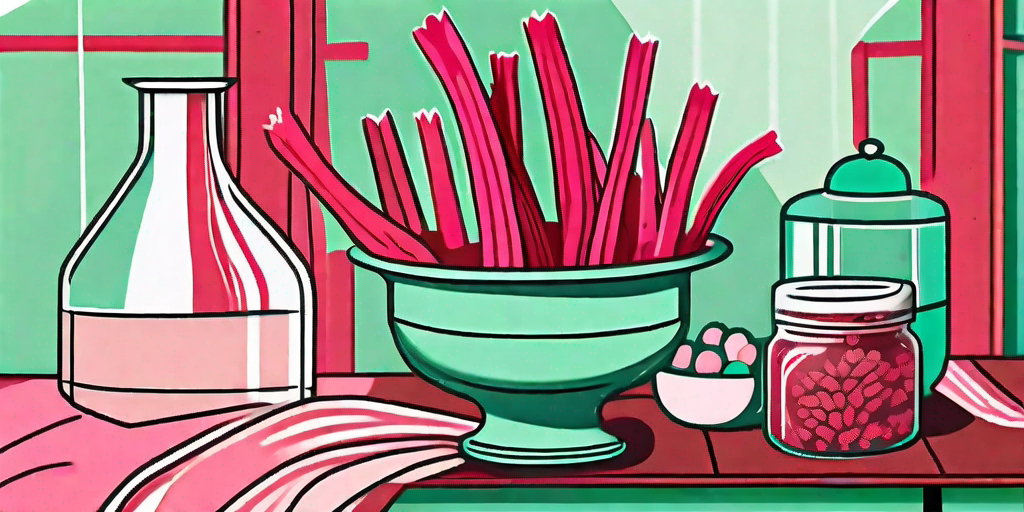
Spring is upon us, and with it comes the delightful prospect of fresh, seasonal produce. Among the first to make an appearance is the vibrant, tangy rhubarb. But did you know that there's a way to enjoy this tart treat even earlier in the year? It's called 'forcing' and it's not nearly as violent as it sounds. In fact, it's a simple gardening trick that can yield sweet, tender stems perfect for your springtime desserts. So, grab your gardening gloves and your sweet tooth, and let's dive into the world of forced rhubarb.
Understanding Rhubarb: The Sweet and Sour Delight
What is Rhubarb?
Rhubarb, for the uninitiated, is a perennial plant with large, leafy green tops and long, edible stalks that range in color from green to deep red. It's often mistaken for a fruit, thanks to its tart flavor and frequent use in desserts, but it's actually a vegetable. And a rather unique one at that.
One of the most interesting things about rhubarb is its versatility. It's equally at home in sweet pies and crumbles as it is in savory sauces and stews. But it's in the realm of desserts that rhubarb truly shines, its tangy flavor providing a perfect counterpoint to the sweetness of sugar and pastry.
The Two Types of Rhubarb
There are two main types of rhubarb: field-grown and forced. Field-grown rhubarb is what you'll typically find in grocery stores and farmers markets. It's harvested in the spring and early summer, and its stalks are usually a deep red or green color with a robust, tart flavor.
Forced rhubarb, on the other hand, is a bit of a delicacy. It's grown in the dark and harvested by candlelight, resulting in tender, pale pink stalks that are sweeter and less fibrous than their field-grown counterparts. This is the rhubarb that we'll be focusing on today.
The Art of Forcing Rhubarb
How to Force Rhubarb
Forcing rhubarb is a surprisingly simple process. All you need is a healthy rhubarb plant, a large pot or bucket, and a little bit of patience. The idea is to trick the plant into thinking it's spring by providing it with a warm, dark environment. This encourages the plant to send up tender, sweet shoots in search of light.
Start by choosing a rhubarb plant that's at least two years old. This ensures that the plant is mature enough to withstand the forcing process. In late winter or early spring, cover the plant with a large pot or bucket. This blocks out the light and creates a warm, cozy environment for the plant. Leave the pot in place for about eight weeks, checking periodically to see if the stalks are ready to harvest.
Harvesting Forced Rhubarb
Harvesting forced rhubarb is a bit of a magical experience. Because the stalks are grown in the dark, they're typically harvested by candlelight to prevent them from turning green and becoming tough. To harvest, simply grasp the base of the stalk and pull gently. The stalk should come away easily. If it doesn't, it's not ready to be harvested.
Once harvested, forced rhubarb should be used immediately for the best flavor. It's perfect for desserts like pies, crumbles, and compotes, where its sweet, delicate flavor can really shine.
Delicious Desserts with Forced Rhubarb
Rhubarb Crumble
One of the most classic uses for rhubarb is in a crumble. The tartness of the rhubarb pairs perfectly with the sweet, buttery crumble topping. To make a rhubarb crumble, simply chop your rhubarb into chunks, toss with sugar, and place in a baking dish. Top with a mixture of flour, sugar, and butter, then bake until golden and bubbly.
Rhubarb Pie
Another classic dessert is rhubarb pie. This is a bit more involved than a crumble, as it requires making a pie crust, but the result is worth the effort. The sweet, tangy filling is a perfect match for the flaky, buttery crust. Plus, a slice of rhubarb pie is a sure sign that spring has arrived.
Frequently Asked Questions
- Can I force rhubarb at any time of the year?
While it's possible to force rhubarb at other times, it's traditionally done in late winter or early spring. This is when the plant is naturally starting to wake up from its winter dormancy, so it's more likely to respond well to forcing.
- Can I force the same rhubarb plant every year?
It's best to give your rhubarb plant a break after forcing. Forcing can be quite stressful for the plant, so it's a good idea to let it recover for a year or two before forcing it again.
- What can I do with the leaves of the rhubarb plant?
Rhubarb leaves are actually toxic and should not be eaten. However, they can be composted, so they're not a total waste.
So there you have it, the sweet and sour world of forced rhubarb. With a little bit of effort and a lot of patience, you can enjoy this springtime delicacy even earlier in the year. Now, who's ready for dessert?











